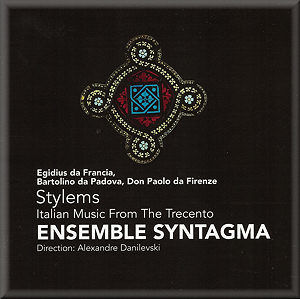 |
 |
|


alternatively
CD: MDT
AmazonUK
AmazonUS |
Stylems - Italian Music from the
Trecento
see end of review for track listing
 Ensemble Syntagma (Mami Irisawa (soprano), Akira Tachikawa (alto),
Bernhard Stilz (recorders), Benoît Stasiascyk (percussion),
Sophia Danilevski (tromba marina), Aexandre Danilevski (lute, colichon,
fiddle, clavichord, portative organ); with Anne Rongy (fiddle),
M. Art (harp))/Alexandre Danilevski
Ensemble Syntagma (Mami Irisawa (soprano), Akira Tachikawa (alto),
Bernhard Stilz (recorders), Benoît Stasiascyk (percussion),
Sophia Danilevski (tromba marina), Aexandre Danilevski (lute, colichon,
fiddle, clavichord, portative organ); with Anne Rongy (fiddle),
M. Art (harp))/Alexandre Danilevski
rec. 5-7 July 2007, 15 February (*) at the Chapelle Saint-Augustin,
Bitche, France. DDD
 CHALLENGE CLASSICS CC72195 [58:13] CHALLENGE CLASSICS CC72195 [58:13] 
|
|
|
The music of the Trecento - as the 14th century in Italy is
usually called - belongs to the most sophisticated of the renaissance.
This was partly due to a change in the notational system at
the end of the 13th century. This made it possible to determine
the rhythmic value of every single note. But social and political
developments also played their part. There was a greater focus
on the individuality of composers who wanted to put their personal
stamp on their compositions. And Italian cities competed with
each other, also in the realm of the arts. Florence and Padua
were two of the main centres of music in the Trecento.
Music played an important role in society, as both literature
and pictures show. Texts by famous poets, like Petrarch, were
set to music, and instruments had their share in music-aking.
The latter is in particular relevant in regard to this disc.
In his liner-notes the artistic leader of the Ensemble Syntagma,
Alexandre Danilevski, emphasises the emancipation of instruments
which became more independent from the text. This is also the
reason almost all pieces on this disc are performed with one
or two instruments. In the pieces which are performed vocally
they either play one of the parts or colla voce. A number
of pieces are performed instrumentally. There is ample evidence
of this practice, as there are collections of instrumental transcriptions
of vocal music, like the Faenza Codex.
The documentation of this disc is pretty poor. There is scarce
biographical information about the composers and no explanation
of the differences between the three musical forms which are
represented here, the madrigal - which has no connection
to the madrigal of the late renaissance - the ballata
and the caccia. The track-list doesn't tell us whether
a piece is scored for two or for three voices, and which instruments
are used. Alexandre Danilevski plays several instruments, among
them the colichon, but the booklet doesn't explain what
kind of instrument it is. New Grove and a search on the
internet shed no light on this mystery. In two texts we see
a dotted line between two sections. This seems to indicate that
the text has survived incomplete, but that isn't explained.
And there is also no reference to the sources for the various
pieces or the authors of the lyrics.
Those omissions are serious, but it shouldn't dissuade anybody
with a special interest in this repertoire purchasing this disc.
The music is exquisite, and the performances are really good.
The voices of the soprano Mami Irisawa and male alto Akira Tachikawa
match perfectly, which is especially important as in some items
they sing unisono. The texts are not always easy to understand,
but that has mainly to do with the use of instruments. In particular
if an instrument plays the same line as the voice the whole
performance gets a more instrumental than vocal character. But
this is in line with the view of the director about the importance
of instruments in this repertoire.
The instruments are played very well and mostly adapt perfectly
to the voices. I don't quite understand the use of percussion
in a couple of items nor do I understand why the first piece
of the programme has to be repeated at the end. Moreover the
use of a wind instrument and a string instrument within one
piece - recorder and fiddle in tracks 9 and 12 - seems also
questionable from a historical point of view.
The quality of the music and the level of singing and playing
are part of the attraction of this disc. Moreover Danilevski
has chosen pieces which figure infrequently in programmes of
music from the Trecento. That makes this disc all the more commendable.
Johan van Veen
see also review by Glyn
Pursglove
Track listing
Anon (14th C)
Che ti zova nasconder, ballata [5:10]
Egidius Da FRANCIA (2nd half 14th C)
Alta serena luce, ballata [3:30]
Anon
Aquila altera, madrigal* [2:55]
Bartolino Da PADOVA (c.1365-1405)
Per un verde boschetto, ballata [2:39]
Donato Da FIRENZE (2nd half 14th C)
Senti tu d'amor, ballata [2:51]
Faccia chi de' se'l po', caccia [2:53]
Don Paolo Da FIRENZE (c.1355-c1436)
Benche partito da te, ballata [3:29]
Amor, tu solo 'l sai, ballata [2:51]
Anon
Quando i oselli canta, madrigal [2:45]
Don Paolo Da FIRENZE
Che l'agg'i' fatto, ballata [3:55]
Ghirardello Da FIRENZE (c.1320/25-1362/63)
La bella e la veççosa cabriola* [3:05]
Anon
Pescando in aqua dolce, madrigal [2:45]
Egidius Da FRANCIA
Qual lege move, madrigal [4:10]
Egidius Da FRANCIA
Mille mercede amor, ballata [3:00]
Don Paolo Da FIRENZE
Chi vuol veder, ballata [4:15]
Anon
O crudel donna, madrigal [2:48]
Anon (14th C)
Che ti zova nasconder, ballata [5:08]
|
|

